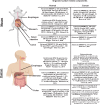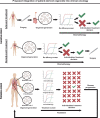Tumor organoids to study gastroesophageal cancer: a primer
- PMID: 32652008
- PMCID: PMC7683018
- DOI: 10.1093/jmcb/mjaa035
Tumor organoids to study gastroesophageal cancer: a primer
Abstract
Gastroesophageal cancers are leading causes of cancer death. Our attempts at adopting molecularly based treatment approaches have been slow and ineffective even though we begin to identify specific targetable gene mutations and pathways. It is clear that we should no longer treat all gastroesophageal cancers as a homogeneous disease, which is what we do when we use non-specific chemotherapy. However, we currently cannot monitor successful gene/pathway targeting, nor understand how/when tumors develop resistance, nor predict which patients will derive maximal benefit. To improve outcomes, we must precisely detail the heterogeneity of these tumors to then individualize cancer therapy as well as develop novel avenues to study and predict treatment effects in individual patients. To this end, patient-derived organoids, in which tumor cells from individual patients are grown in a Petri dish, are a new versatile system that allows for timely expandability, detailed molecular characterization, and genetic manipulation with the promise of enabling predictive assessment of treatment response. In this review, we will explore the development and basic techniques for organoid generation, and discuss the current and potential future applications of this exciting technology to study the basic science of carcinogenesis and to predict/guide cancer patient care in the clinics.
Keywords: cancer evolution; cancer model; personalized medicine; precision oncology; targeted therapy; tumor heterogeneity.
© The Author(s) (2020). Published by Oxford University Press on behalf of Journal of Molecular Cell Biology, IBCB, SIBS, CAS.
Figures




Similar articles
-
Updates in Translational Science for Esophageal and Gastric Cancers.Surg Oncol Clin N Am. 2024 Jul;33(3):571-581. doi: 10.1016/j.soc.2023.12.022. Epub 2024 Jan 20. Surg Oncol Clin N Am. 2024. PMID: 38789199 Review.
-
Three-Dimensional Organoids Reveal Therapy Resistance of Esophageal and Oropharyngeal Squamous Cell Carcinoma Cells.Cell Mol Gastroenterol Hepatol. 2018 Sep 14;7(1):73-91. doi: 10.1016/j.jcmgh.2018.09.003. eCollection 2019. Cell Mol Gastroenterol Hepatol. 2018. PMID: 30510992 Free PMC article.
-
Unlocking the potential of organoids in cancer treatment and translational research: An application of cytologic techniques.Cancer Cytopathol. 2024 Feb;132(2):96-102. doi: 10.1002/cncy.22769. Epub 2023 Oct 16. Cancer Cytopathol. 2024. PMID: 37843532 Review.
-
An Organoid-Based Preclinical Model of Human Gastric Cancer.Cell Mol Gastroenterol Hepatol. 2019;7(1):161-184. doi: 10.1016/j.jcmgh.2018.09.008. Epub 2018 Sep 20. Cell Mol Gastroenterol Hepatol. 2019. PMID: 30522949 Free PMC article.
-
Patient-derived cancer organoids for drug screening: Basic technology and clinical application.J Gastroenterol Hepatol. 2022 Aug;37(8):1446-1454. doi: 10.1111/jgh.15930. Epub 2022 Jul 7. J Gastroenterol Hepatol. 2022. PMID: 35771719 Review.
Cited by
-
Understanding the cellular origin and progression of esophageal cancer using esophageal organoids.Cancer Lett. 2021 Jul 1;509:39-52. doi: 10.1016/j.canlet.2021.03.031. Epub 2021 Apr 7. Cancer Lett. 2021. PMID: 33838281 Free PMC article. Review.
-
Application of Organoids in Carcinogenesis Modeling and Tumor Vaccination.Front Oncol. 2022 Mar 17;12:855996. doi: 10.3389/fonc.2022.855996. eCollection 2022. Front Oncol. 2022. PMID: 35371988 Free PMC article. Review.
-
Organoid models of ovarian cancer: resolving immune mechanisms of metabolic reprogramming and drug resistance.Front Immunol. 2025 Mar 21;16:1573686. doi: 10.3389/fimmu.2025.1573686. eCollection 2025. Front Immunol. 2025. PMID: 40191206 Free PMC article. Review.
-
Gastric Organoids: Progress and Remaining Challenges.Cell Mol Gastroenterol Hepatol. 2022;13(1):19-33. doi: 10.1016/j.jcmgh.2021.09.005. Epub 2021 Sep 20. Cell Mol Gastroenterol Hepatol. 2022. PMID: 34547535 Free PMC article. Review.
-
Current trends and future prospects of drug repositioning in gastrointestinal oncology.Front Pharmacol. 2024 Jan 4;14:1329244. doi: 10.3389/fphar.2023.1329244. eCollection 2023. Front Pharmacol. 2024. PMID: 38239190 Free PMC article. Review.
References
-
- Bang Y.J., Van Cutsem E., Feyereislova A., et al. (2010). Trastuzumab in combination with chemotherapy versus chemotherapy alone for treatment of HER2-positive advanced gastric or gastro-oesophageal junction cancer (ToGA): a phase 3, open-label, randomised controlled trial. Lancet 376, 687–697. - PubMed
-
- Barker N., Huch M., Kujala P., et al. (2010). Lgr5+ve stem cells drive self-renewal in the stomach and build long-lived gastric units in vitro. Cell Stem Cell 6, 25–36. - PubMed
-
- Barker N., Ridgway R.A., van Es J.H., et al. (2009). Crypt stem cells as the cells-of-origin of intestinal cancer. Nature 457, 608–611. - PubMed
-
- Barker N., van Es J.H., Kuipers J., et al. (2007). Identification of stem cells in small intestine and colon by marker gene Lgr5. Nature 449, 1003–1007. - PubMed
Publication types
MeSH terms
Grants and funding
LinkOut - more resources
Full Text Sources
Medical

